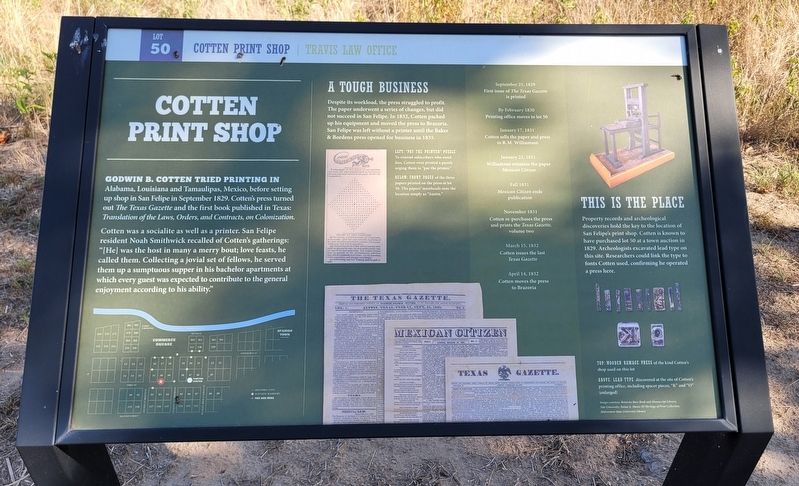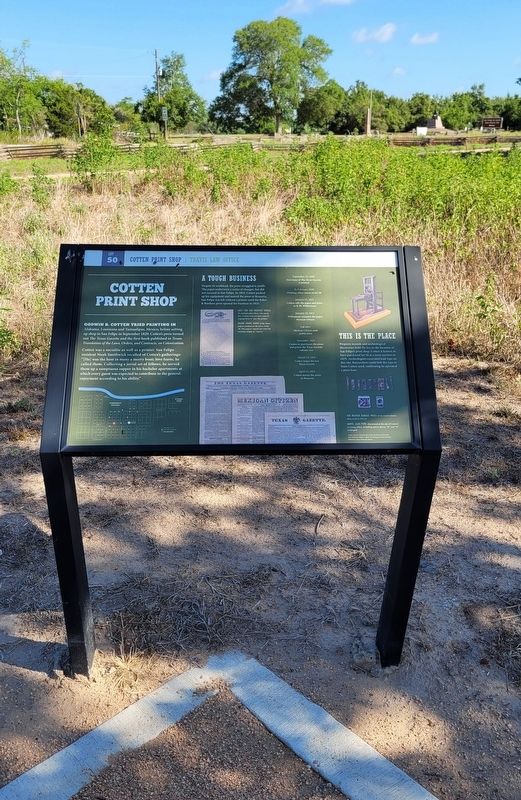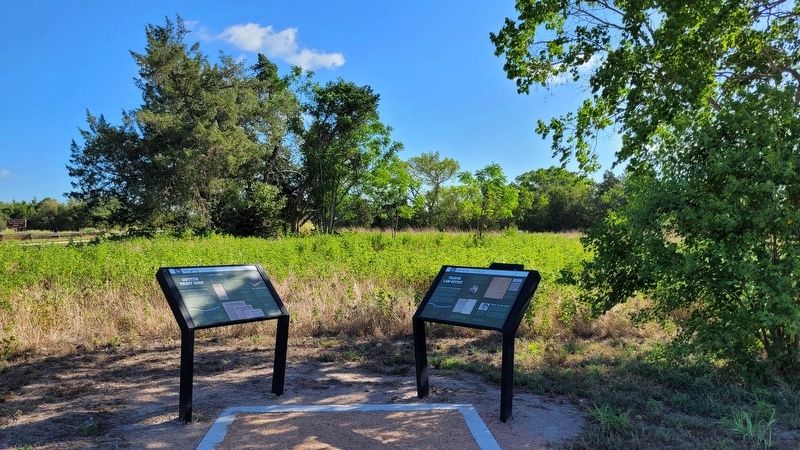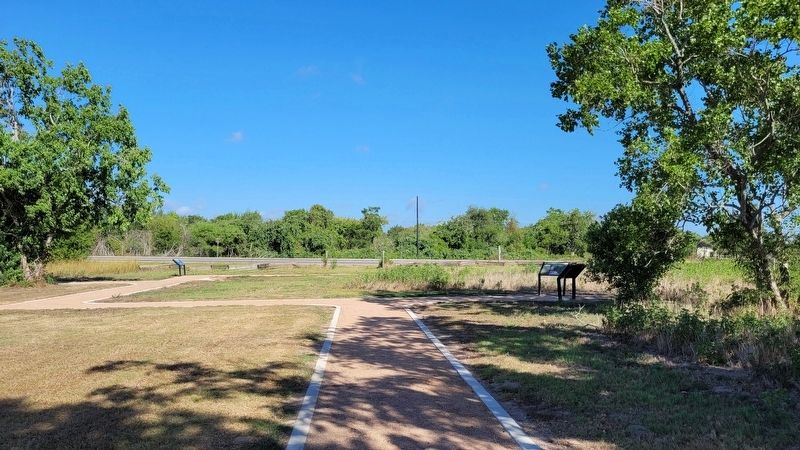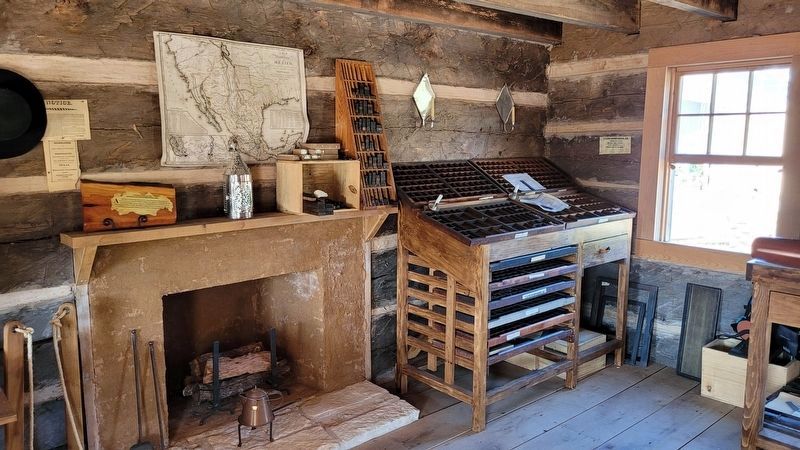San Felipe in Austin County, Texas — The American South (West South Central)
Cotten Print Shop
Lot 50
— Cotten Print Shop - Travis Law Office —
Godwin B. Cotten tried printing in Alabama, Louisiana and Tamaulipas, Mexico, before setting out The Texas Gazette and the first book published in Texas: Translation of the Laws, Orders, and Contracts, on Colonization.
Cotten was a socialite as well as a printer. San Felipe resident Noah Smithwick recalled of Cotten's gatherings: "[He] was the host in many a merry bout; love feasts, he called them. Collecting a jovial set of fellows, he served them up a sumptuous supper in his bachelor apartments at which every guest was expected to contribute to the general enjoyment according to his ability."
A Tough Business
Despite its workload, the press struggled to profit. The paper underwent a series of changes, but did not succeed in San Felipe. In 1832, Cotten packed up his equipment and moved the press to Brazoria. San Felipe was left without a printer until the Baker & Bordens press opened for business in 1835.
First issue of The Texas Gazette
is printed
By February 1830
Printing office moves to lot 50
January 17, 1831
Cotten sells the paper and press
to R.M. Williamson
January 22, 1831
Williamson renames the paper
Mexican Citizen
Fall 1831
Mexican Citizen ends
publication
November 1831
Cotten re-purchases the press
and prints the Texas Gazette,
volume two
March 15, 1832
Cotten issues the last
Texas Gazette
April 14, 1832
Cotten moves the press
to Brazoria
Property records and archeological discoveries hold the key to the location of San Felipe's print shop. Cotten is known to have purchased lot 50 at a town auction in 1829. Archeologists excavated lead type on this site. Researchers could link the type to fonts Cotten used, confirming he operated a press here.
Captions
Center (1): Left: "Pay the Printer" Puzzle To remind subscribers who owed fees, Cotten even printed a puzzle urging them to "pay the puzzle".
Center (2): Below: Front Pages of the three papers printed on the press at lot 50. The papers' mastheads note the location simply as "Austin."
Lower Right (1): Top: Wooden Ramage Press of the kind Cotten's shop used on this lot
Lower Right (2): Above: Lead Type discovered at the site of Cotten's printing office, including spacers pieces, "K" and "O" (enlarged)
Images courtesy: Beinecke Rare Book and Manscript Library; Yale University; Nolan A. Moore III Heritage of Print Collection, Midwestern State University Library
Erected by San Felipe de Austin State Historic Site.
Topics. This historical marker is listed in these topic lists: Communications • War, Texas Independence. A significant historical year for this entry is 1832.
Location. 29° 48.347′ N, 96° 5.851′ W. Marker is in San Felipe, Texas, in Austin County. Marker can be reached from the intersection of 2nd Street and Farm to Market Road 1458. The marker is located in the western section of the San Felipe de Austin State Historic Site along the pathway. Touch for map. Marker is at or near this postal address: 220 2nd Street, San Felipe TX 77473, United States of America. Touch for directions.
Other nearby markers. At least 8 other markers are within walking distance of this marker. Travis Law Office (here, next to this marker); Jane Wilkins' Home (within shouting distance of this marker); Burning of the Town (within shouting distance of this marker); Austin & Perry Stores (within shouting distance of this marker); Business District (about 300 feet away, measured in a direct line); Clopper Store (about 300 feet away); Rio Brazos (about 300 feet away); Governing the Town (about 400 feet away). Touch for a list and map of all markers in San Felipe.
More about this marker. The marker is located on the grounds of the San Felipe de Austin Historic Site. There is a small fee
to access the historic site and markers.
Also see . . .
1. San Felipe de Austin History. Texas Historical Commission website entry:
The town was the social, economic and political center of the Austin colony. Its expanding but unstable population was swelled by large numbers of immigrants and other transients. Austin built a residence on Bullinger's Creek, a half mile west of the Brazos, from which he directed the government of his colony for four years before handing responsibility for the management of most affairs to the ayuntamiento, the principal governing body of Spanish municipalities, of San Felipe in 1828. The colonial land office was headquartered in the town, and Austin assumed an active role in its operation. Regular mail service in the colony was inaugurated in 1826 when Samuel May Williams was appointed postmaster in San Felipe de Austin. With seven separate postal routes converging here, the town remained the hub of the Texas postal service until the Texas Revolution in 1836. One of the earliest newspapers in Texas, the Texas Gazette, began publication in San Felipe on September 25, 1829. Gail Borden’s Telegraph and Texas Register, which became the unofficial journal of the revolution, was first published in San Felipe de Austin on October 10, 1835.(Submitted on September 17, 2022, by James Hulse of Medina, Texas.)
2. Texas Gazette
. Texas State Historical Association website entry:
The Texas Gazette was published between 1829 and 1832, first at San Felipe de Austin and then at Brazoria. It was a typical frontier newspaper of four pages an issue, three columns a page; it usually measured 9˝ inches by twelve inches and was printed in small type. The paper was generally in English but sometimes in Spanish. Although advertised as a weekly, it was very irregular. Godwin Brown Cotten began publishing the Texas Gazette on September 25, 1829, at San Felipe de Austin. The three major contributors-Robert McAlpin Williamson, Stephen F. Austin, and Cotten-often held divergent views. The opinions of Cotten and Austin often clashed. Williamson was on good terms with both men and often helped ease the tension between them. Austin also patronized the Gazette printing shop.(Submitted on September 17, 2022, by James Hulse of Medina, Texas.)
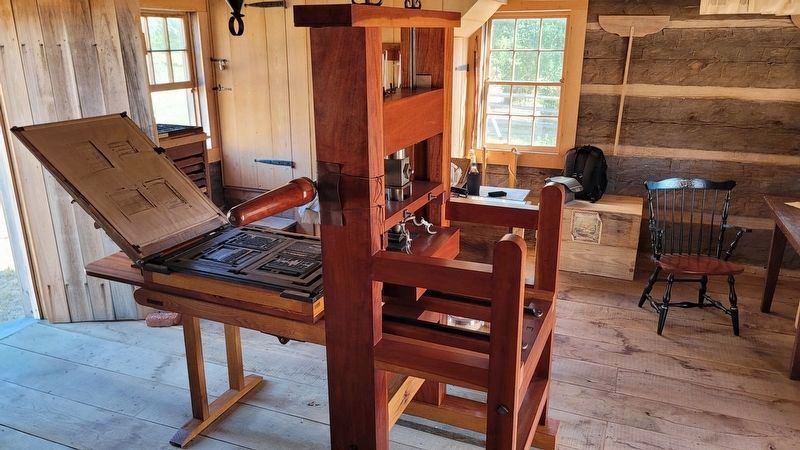
Photographed By James Hulse, July 20, 2022
5. Printing Press at San Felipe de Austin
The printing press is located on the east side of the visitors center and not at the actual archeological site. The actual site (Lot 50) was proven with print type set artifacts found during archaeological diggings on site.
Credits. This page was last revised on March 5, 2024. It was originally submitted on September 16, 2022, by James Hulse of Medina, Texas. This page has been viewed 94 times since then and 11 times this year. Photos: 1, 2, 3, 4, 5, 6. submitted on September 17, 2022, by James Hulse of Medina, Texas.
